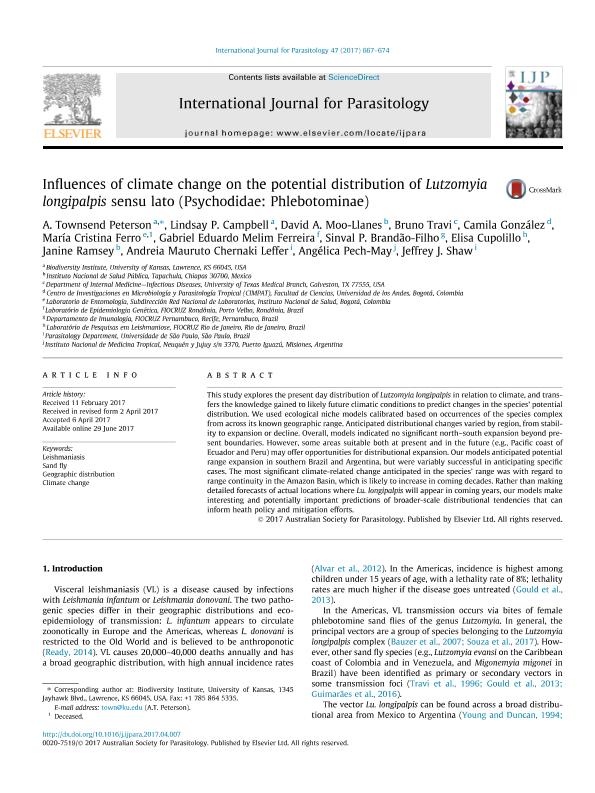Artículo
Influences of climate change on the potential distribution of Lutzomyia longipalpis sensu lato (Psychodidae: Phlebotominae)
Peterson, A. Townsend; Campbell, Lindsay P.; Moo Llanes, David A.; Travi, Bruno; González, Camila; Ferro, María Cristina; Melim Ferreira, Gabriel Eduardo; Brandão Filho, Sinval P.; Cupolillo, Elisa; Ramsey, Janine; Leffer, Andreia Maruruto Chernaki; Pech May, Angélica del Rosario ; Shaw, Jeffrey J.
; Shaw, Jeffrey J.
 ; Shaw, Jeffrey J.
; Shaw, Jeffrey J.
Fecha de publicación:
09/2017
Editorial:
Elsevier
Revista:
International Journal for Parasitology
ISSN:
0020-7519
Idioma:
Inglés
Tipo de recurso:
Artículo publicado
Clasificación temática:
Resumen
This study explores the present day distribution of Lutzomyia longipalpis in relation to climate, and transfers the knowledge gained to likely future climatic conditions to predict changes in the species' potential distribution. We used ecological niche models calibrated based on occurrences of the species complex from across its known geographic range. Anticipated distributional changes varied by region, from stability to expansion or decline. Overall, models indicated no significant north' south expansion beyond present boundaries. However, some areas suitable both at present and in the future (e.g., Pacific coast of Ecuador and Peru) may offer opportunities for distributional expansion. Our models anticipated potential range expansion in southern Brazil and Argentina, but were variably successful in anticipating specific cases. The most significant climate-related change anticipated in the species' range was with regard to range continuity in the Amazon Basin, which is likely to increase in coming decades. Rather than making detailed forecasts of actual locations where Lu. longipalpis will appear in coming years, our models make interesting and potentially important predictions of broader-scale distributional tendencies that can inform heath policy and mitigation efforts.
Palabras clave:
Leishmaniasis
,
Sand Fly
,
Geographic Distribution
,
Climate Change
Archivos asociados
Licencia
Identificadores
Colecciones
Articulos(CCT - NORDESTE)
Articulos de CTRO.CIENTIFICO TECNOL.CONICET - NORDESTE
Articulos de CTRO.CIENTIFICO TECNOL.CONICET - NORDESTE
Citación
Peterson, A. Townsend; Campbell, Lindsay P.; Moo Llanes, David A.; Travi, Bruno; González, Camila; et al.; Influences of climate change on the potential distribution of Lutzomyia longipalpis sensu lato (Psychodidae: Phlebotominae); Elsevier; International Journal for Parasitology; 47; 10-11; 9-2017; 667-674
Compartir
Altmétricas



